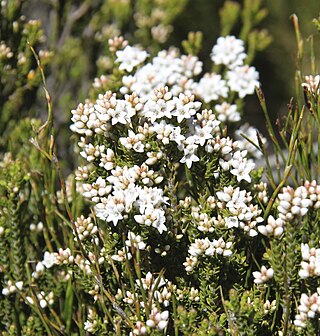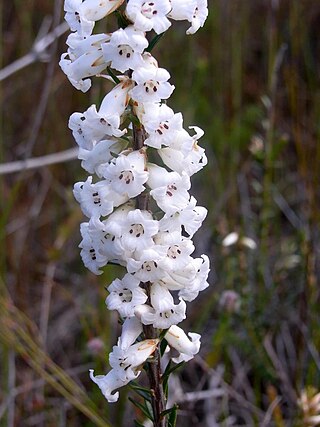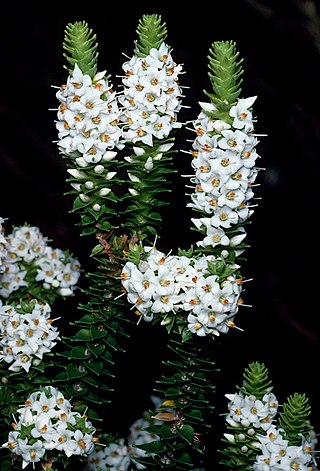
Epacris is a genus of about forty species of flowering plants in the family Ericaceae. It was formerly treated in a closely related but separate family Epacridaceae, but the various genera within Epacridaceae including Epacris have been revised in their relationships to each other and brought under the common umbrella of the Ericaceae. The genus Epacris is native to eastern and southeastern Australia, New Caledonia and New Zealand. The species are known as heaths or Australian heaths.

Epacris glacialis, commonly known as reddish bog-heath, is a species of flowering plant in the family Ericaceae and is endemic to south-eastern continental Australia. It is a prostrate to low-lying shrub with crowded, rhombus-shaped to broadly egg-shaped leaves with the narrower end towards the base, and tube-shaped, white flowers in small clusters near the ends of the branches.

Epacris microphylla , commonly known as coral heath, is a plant in the heath family Ericaceae and which is endemic to eastern Australia. It is a common, wiry shrub with tiny leaves that are often obscured by the flowers, especially near the ends of the stems. The plant sometimes grows in dense groups, giving the effect of a snowfall.

Epacris pulchella, commonly known as wallum heath or coral heath is a species of flowering plant in the family Ericaceae and is endemic to eastern Australia. It is a slender, erect shrub with egg-shaped, pointed leaves and white or pinkish, tube-shaped flowers.

Epacris obtusifolia, commonly known as blunt-leaf heath, is a species of flowering plant from the heath family, Ericaceae, and is endemic to eastern Australia. It is an erect shrub with few stems, crowded, oblong to elliptic leaves and tube-shaped white or cream-coloured flowers arranged along the stems.

Epacris muelleri, commonly known as Mueller's heath, is a species of flowering plant in the heath family Ericaceae and is endemic to eastern New South Wales. It is an erect, or weak straggling shrub with more or less glabrous branchlets, elliptic leaves and white or cream-coloured, tube-shaped flowers.

Epacris gnidioides, commonly known as Budawangs cliff-heath, is a species of flowering plant in the heath family Ericaceae and is endemic to a restricted area of New South Wales. It is a small, creeping shrub with hairy branches, sharply-pointed lance-shaped leaves, and tube-shaped, white flowers. Originally described as Rupicola gnidioides, it was at one time regarded as the only species in the genus Budawangia under the synonym Budawangia gnidioides.

Epacris crassifolia is a species of flowering plant in the heath family Ericaceae and is endemic to south-eastern New South Wales, Australia. It is a low-lying shrub with elliptic to egg-shaped leaves with the lower end towards the base, and tube-shaped, white or cream-coloured flowers clustered near the ends of the branches.

Epacris apiculata is a species of flowering plant in the heath family Ericaceae and is endemic to a small area of New South Wales. It is a small, slender, low-lying to erect shrub with hairy branchlets, egg-shaped leaves with a thickened, pointed tip and tube-shaped flowers with white petals.
Epacris apsleyensis is a species of flowering plant in the heath family Ericaceae and is endemic to a small area of Tasmania. It is an erect shrub with hairy branchlets, lance-shaped to elliptic leaves and tube-shaped flowers with white petals.

Epacris celata is a species of flowering plant in the heath family Ericaceae and is endemic to south-eastern continental Australia. It is a spreading to erect shrub with flat, elliptic to egg-shaped leaves with the narrower end towards the base, and tube-shaped white flowers clustered in upper leaf axils.
Epacris grandis, commonly known as grand heath or tall heath, is a species of flowering plant in the heath family Ericaceae and is endemic to a small area of Tasmania. It is a robust, erect shrub with smooth stems, lance-shaped leaves and tube-shaped flowers with white petals.

Epacris graniticola, commonly known as granite heath, is a species of flowering plant in the heath family Ericaceae and is endemic to Tasmania. It is an erect shrub with egg-shaped leaves and tube-shaped white flowers mostly clustered near the ends of branches.
Epacris lithophila is a species of flowering plant in the heath family Ericaceae and is endemic to a small area of New South Wales. It is an erect shrub with few branches, lance-shaped to elliptic leaves and creamy-white, tube-shaped flowers.

Epacris mucronulata is a species of flowering plant in the heath family Ericaceae and is endemic to Tasmania. It is an erect shrub with softly-hairy young branches, lance-shaped leaves, and cylindrical white flowers in small groups at the ends of the branches.
Epacris pilosa is a species of flowering plant in the heath family Ericaceae and is endemic to eastern New South Wales. It is low-lying shrub with weeping, shaggy-hairy branchlets, elliptic to more or less egg-shaped leaves and white or cream-coloured tube-shaped flowers.
Epacris pinoidea is a species of flowering plant in the heath family Ericaceae and is endemic to a small area of eastern New South Wales. It is an erect to semi-erect shrub with flat, oblong to elliptic or lance-shaped leaves and white, tube-shaped flowers.

Epacris purpurascens is a species of flowering plant in the heath family Ericaceae and is endemic to eastern New South Wales. It is an erect shrub with egg-shaped or heart-shaped, sharply-pointed leaves and white or pink, tube-shaped flowers.
Epacris rigida is a species of flowering plant in the family Ericaceae and is endemic to eastern New South Wales. It is an erect, bushy shrub with elliptic leaves and white or cream-coloured, tube-shaped flowers.

Epacris tasmanica is a species of flowering plant in the heath family Ericaceae and is endemic to Tasmania. It is an erect shrub with lance-shaped leaves and tube-shaped white flowers crowded in upper leaf axils.















